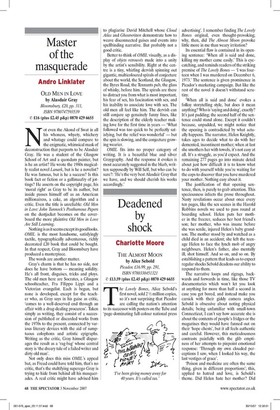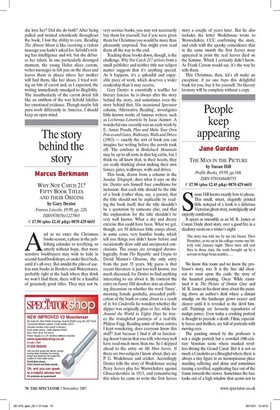Deadened by shock
Charlotte Moore THE ALMOST MOON by Alice Sebold Picador, £16.99, pp. 291, ISBN 9780330451321 £13.59 (plus £2.45 p&p) 0870 429 6655 The Lovely Bones, Alice Sebold's first novel, sold 2 1/2 million copies, so it's not surprising that Picador are calling the nation's attention to its successor with posters on the Tube and 'page-dominating full-colour national press advertising'. I remember finding The Lovely Bones original, even thought-provoking; why, then, did The Almost Moon provoke little more in me than weary irritation?
Its essential flaw is contained in its opening sentence: 'When all is said and done, killing my mother came easily.' This is eyecatching, and reminds readers of the striking premise of The Lovely Bones — 'I was fourteen when I was murdered on December 6, 1973.' The sentence is given prominence in Picador's marketing campaign. But like the rest of the novel it doesn't withstand scrutiny.
'When all is said and done' evokes a folksy storytelling style, but does it mean anything? Who is 'saying and doing', exactly? It's just padding; the second half of the sentence could stand alone. Except it couldn't because, unpadded, we might notice that the opening is contradicted by what actually happens. The narrator, Helen Knightly, takes ages to decide what to do with her demented, incontinent mother; when at last she smothers her with towels, it's not easy at all. It's a struggle, as you'd expect. And the remaining 277 pages go into minute detail about just how difficult it is to know what to do with yourself while you're waiting for the cops to discover that you have murdered your mother. Nothing easy about it.
The justification of that opening sentence, then, is purely to grab attention. This speciousness infects the prose throughout. Nasty revelations occur about once every ten pages, like the sex scenes in the Harold Robbins novels we used to pass round at boarding school. Helen puts her mother in the freezer, seduces her best friend's son; her mother, who was insane before she was senile, injured Helen's baby grandson. The mother stood by and watched as a child died in an accident; she left the teenage Helen to face the lynch mob of angry neighbours. Helen's father, also mentally ill, shot himself. And so on, and so on. By establishing a pattern that leads us to expect regular shocks Sebold deadens our ability to respond to them.
The narrative loops and zigzags, backwards and forwards in time, like those TV documentaries which won't let you look at anything for more than half a second in case you get bored, and instead make you carsick with their giddy camera angles. Sebold is obsessive about noting physical details; being unfamiliar with small-town Connecticut, I can't say how accurate she is about the contents of people's fridges or the magazines they would have fanned out on their 'hope chests', but it all feels authentic and careful. However, this meticulousness contrasts painfully with the glib emptiness of her attempts to pinpoint emotional response: 'Through my own clouded perceptions I saw, when I looked his way, the last vestiges of grace'.
'Poison and medicine are often the same thing, given in different proportions'; this, applied to hatred and love, is Sebold's theme. Did Helen hate her mother? Did she love her? Did she do both? After being pulled and twisted relentlessly throughout the book, I lost the ability to care. Reading The Almost Moon is like receiving a violent massage you hadn't asked for. Sebold's writing has intelligence and wit, but she debases her talent. In one particularly deranged moment, the young Helen slices carrots, writes messages in felt pen on the slices and leaves them in places where her mother will find them, like her shoes. I tried writing on bits of carrot and, as I expected, the writing immediately smudged to illegibility. The inauthenticity of the carrot detail felt like an emblem of the way Sebold falsifies her emotional evidence. Though maybe felt pens work differently in America. I should keep an open mind.













































































 Previous page
Previous page